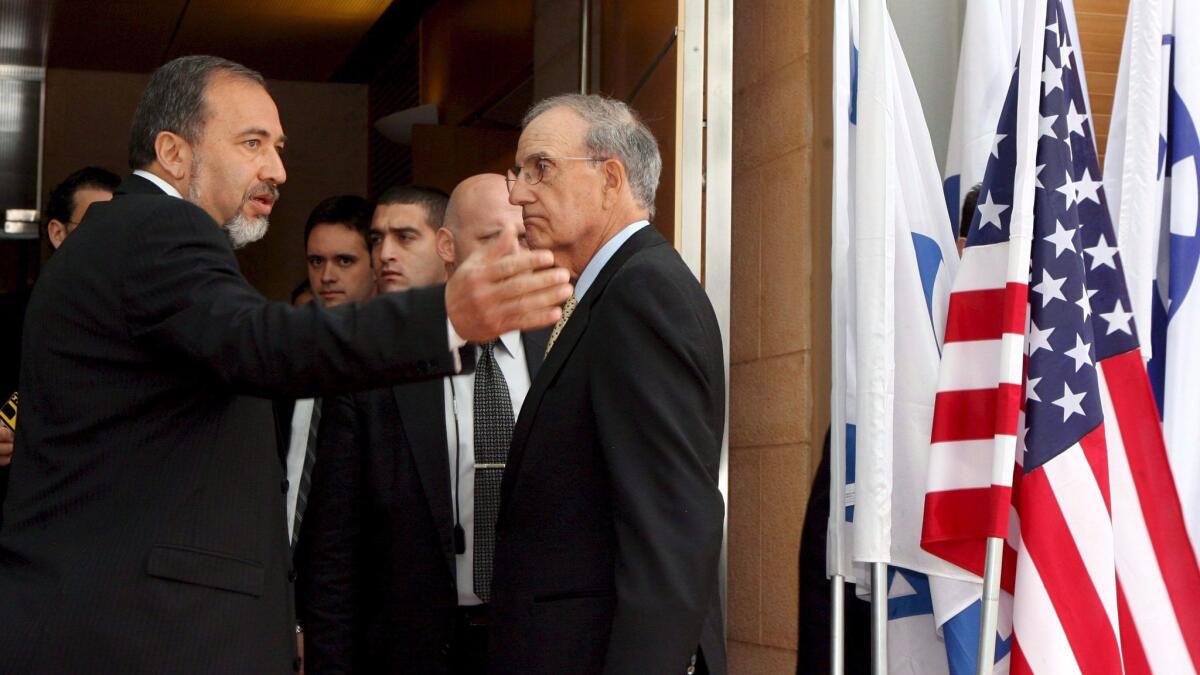Review: George Mitchell wrote ‘A Path to Peace’ about Israel and Palestine. Is there one?

In the summer of 2016, while walking through the Christian Quarter in Jerusalem’s Old City, I passed by a dry-goods store. A framed picture hung prominently on the shop’s walls. It was of the Egyptian leader Gamal Abdel Nasser, the self-appointed apostle of pan-Arabism, prime mover of the 1967 war and sworn enemy of a state that was — and still sometimes is — spitefully referred to by its neighbors only as the “Zionist entity” instead of its actual name: Israel.
It was a jarring juxtaposition. Nearly 50 years after Israel wrested control of East Jerusalem, including the Old City, from Jordan (which had occupied it and the West Bank for 19 years), Nasser was still being lionized in the heart of the city that some Israeli politicians, with some chutzpah, call their “eternal and indivisible” capital.
A few minutes later I walked through the Jewish Quarter. As I passed by a number of street markers, I noticed that someone had defaced all the Arabic place-names, literally rubbing them out from the plaques themselves. (Arabic is one of Israel’s two official languages.)
Historical memory is a form of warfare. And when, as with Israelis and Palestinians, a conflict is so intense that hanging stock portraiture, or the recognition of a native tongue, can be construed as incendiary, diplomats must reckon with a great chasm separating the two antagonists, which can — and often do — derail negotiations before they even begin.
“A Path to Peace,” by former Senate Majority Leader George Mitchell, and Alon Sachar, who worked under Mitchell while at the State Department, shows the extent of this challenge, even for a veteran negotiator. The book has three parts: a condensed history of the conflict; a detailed account of Mitchell’s frustrating (and frustrated tenure) as President Obama’s special envoy for Middle East peace from 2009 to 2011; and the outlines for a two-state partition plan. All of this is contained in a rather slim, if congenially brisk, volume. While President Trump has argued for a more transactional approach to U.S. foreign policy, this book might help educate him about the deep historical and cultural drivers of the conflict.

The middle third of “A Path to Peace,” where Mitchell describes his experience trying to bring Israelis and Palestinians to the negotiating table, is the book’s most illuminating section. Mitchell, the architect of the 1998 Good Friday Agreement (which ended the decades-long conflict in Northern Ireland), seemed to undertake his responsibilities as special envoy with admirable probity and seriousness. But his approach to the conflict — which reflects a long-standing American bipartisan consensus about the “two-state solution” — appears, especially at our current moment, depressingly conventional.
To understand why, we need to step back and look at the larger political framework informing the proposed partition process itself. Israel is a key ally for America in the Middle East, and the two countries share strong cultural, economic and political affinities, and important military and intelligence ties. Israel, although a tiny country, contains multitudes: It is cosmopolitan and secular Tel Aviv; it is Jerusalem, steeped in — and being pulled apart by — the multiple religious faith and traditions that deem the city holy; it is Nazareth, a bastion of Israeli Arab (or Palestinian Israeli) commerce and culture; and it is beleaguered, bleak Sderot, populated almost exclusively by Mizrahi Jews (that is, Jews of Middle Eastern descent, about 700,000 of whom fled or were expelled from their homes across the region after Israel’s founding).
But Israel is also an occupying power, subjecting millions of Palestinians in the West Bank (and, with important distinctions, in East Jerusalem) to a military regime that systematically violates their individual civil and human rights and squashes their collective right to self-determination. Human Rights Watch has called Israel’s treatment of Palestinians “severe and discriminatory” and its settlement enterprise “unlawful.”
The American attitude, embodied by Mitchell, has been to treat Palestinians and Israelis as coequals in the partition, or peace, process. They are not. One party possesses the preponderance of power in the relationship; the other lacks sovereignty — it is in fact negotiating for its sovereignty with another, sovereign entity. Even accounting for the Palestinian Authority’s deficiencies — among them its corruption and authoritarianism — this is the fundamental imbalance in the conflict. Israel has the power to withdraw, or not, from the territories. Palestinians possess, at best, a proto-state entity that is reliant on Israel for its very survival. (It is also dependent on funding from international sources, as the Obama administration’s last-minute $221-million aid disbursement to the Palestinian Authority shows).
Much of “A Path to Peace” deals with the thorny issue of Israel’s settlements. As Mitchell writes, “settlements are an obstacle to peace because they are constructed on land that the Palestinians and the international community, including the United States, believe should be reserved for a Palestinian state.” Here, Mitchell recapitulates the traditional American position, which, although critical of settlements, refrains from explicitly acknowledging the almost-universal consensus (outside of Israel and some in the United States) that they are illegal under international law.
In December 2016, the U.N. spontaneously erupted in applause when — after an abstention from the Obama administration — a resolution condemning Israeli settlements passed the Security Council, the first resolution on Israel and Palestine in almost eight years. The U.S. was now officially inching closer to the consensus international position on settlements. (In fact, the resolution stated that the settlement project possesses “no legal validity and constitutes a flagrant violation under international law and a major obstacle to the achievement of the two-State solution.”)
In the book, Mitchell recalls that in late 2009 he urged Palestinian Authority President Mahmoud Abbas to agree to negotiations, even in the face of continued Israeli construction in contested areas of East Jerusalem (which Palestinians claim as their future capital) or in the West Bank. Abbas refused to do so. As Mitchell writes, Abbas would agree to nothing less than a total settlement freeze as a precondition to talks. Even though continued settlement construction has been widely interpreted as fatal to any peace deal, this was instead cited as evidence of Palestinian intransigence.
Mitchell, meanwhile, took a forbearing approach to Israeli domestic political pressures. He and other Obama administration officials, he writes, “knew that ending settlement activity was a lot to ask of any Israeli government.” Narrowly speaking, this is true: Under that country’s parliamentary system, and especially in a right-wing coalition government such as Prime Minister Benjamin Netanyahu’s, small settler and religious parties do exert disproportionate influence.
But the U.S is uniquely positioned to change the political calculus within Israel. Indeed, in the past both Democratic and Republican presidential administrations have found the will to coerce Israeli governments to cease settlement building or to alter its political positions. For example, in 1991 George H.W. Bush cut off Israeli loan guarantees to force the right-wing government of Yitzhak Shamir to attend the Madrid Peace Conference. The Obama administration failed to apply even this relatively modest amount of pressure on Netanyahu during Mitchell’s time as Middle East envoy.
Obama had a kid-gloves approach toward Netanyahu, despite the sense that the Israeli prime minister was negotiating in bad faith. As Mitchell recounts, for instance, Netanyahu required that, as a precondition to discussion of borders, Israel would need security guarantees that permitted Israeli troops to remain stationed in the Jordan Valley for decades. But, as Mitchell writes, “no Palestinian leader has ever given any indication of a willingness to consent to a long-term Israel military presence,” and, in fact, when Netanyahu broached this subject with Abbas, the latter “strongly and categorically rejected it.” In other words, this proposal was no proposal at all: It was a poison pill.
Consider as well the Israeli government’s March 2010 decision to announce the construction of 1,600 housing units in East Jerusalem while Vice President Biden was meeting with officials in Israel “to underscore the administration’s commitment to the U.S.-Israel relationship.” This was, as Mitchell writes, “a direct and astonishing insult” to the Obama administration. But, again, Obama made no concrete effort to pressure an ally that, at the time, received roughly $3.5 billion a year in military aid. (Indeed, in September 2016, Obama agreed to a 10-year, $38-billion military aid package for Israel, the largest ever made by the U.S.).
As Mitchell notes, Israel does face real, serious security threats emanating from the Occupied Territories, including from radical Islamist groups such as Hamas and Islamic Jihad. The Gaza Strip, which has been controlled by Hamas since 2006, presents a serious challenge to both Palestinian and Israeli negotiators. There are nettlesome questions regarding how the Fatah-aligned Palestinian Authority can legitimately negotiate a lasting peace accord for a discontiguous state when Hamas controls one of the two major constituent parts of a future, independent Palestine. But, paradoxically, as Mitchell also writes, without a peace deal, Israel will cede its capacity to shape its own future — which is the very reason many security-oriented Israelis fear an end to the occupation itself.
Alas, the long-range strategic thinking advocated, if imperfectly and weakly, by Mitchell and the Obama administration now seems a vestige of gone era.
If President Trump’s appointment of David Friedman — who, according to the Israeli newspaper Haaretz “is positioned on the far-right of Israel’s map” and is even more “hardline” than Netanyahu — as U.S. ambassador to Israel is any indication, the situation in the region may rapidly deteriorate. (The Israeli government’s Jan. 24 announcement of a major settlement expansion reflects its newfound sense of latitude under a Trump administration.)
Trump has already promised to move the U.S. embassy in Israel to Jerusalem, a highly incendiary gesture. Looking out at the beautiful West Bank highlands, our new president may not be capable of seeing a contemporary human rights tragedy or an incipient geopolitical disaster. Real estate is what it is, after all, and if this man knows one thing, it’s the value of location, location, location.
Dorfman is a senior fellow at the Carnegie Council for Ethics in International Affairs.
George J. Mitchell and Alon Sachar
Simon & Schuster: 272 pp., $26
More to Read
Sign up for our Book Club newsletter
Get the latest news, events and more from the Los Angeles Times Book Club, and help us get L.A. reading and talking.
You may occasionally receive promotional content from the Los Angeles Times.






